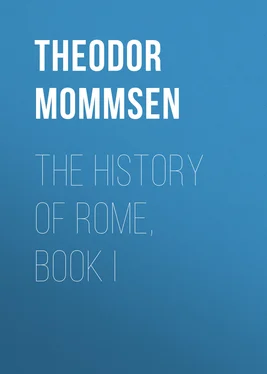Theodor Mommsen - The History of Rome, Book I
Здесь есть возможность читать онлайн «Theodor Mommsen - The History of Rome, Book I» — ознакомительный отрывок электронной книги совершенно бесплатно, а после прочтения отрывка купить полную версию. В некоторых случаях можно слушать аудио, скачать через торрент в формате fb2 и присутствует краткое содержание. Жанр: foreign_prose, История, foreign_edu, foreign_antique, на английском языке. Описание произведения, (предисловие) а так же отзывы посетителей доступны на портале библиотеки ЛибКат.
- Название:The History of Rome, Book I
- Автор:
- Жанр:
- Год:неизвестен
- ISBN:нет данных
- Рейтинг книги:5 / 5. Голосов: 1
-
Избранное:Добавить в избранное
- Отзывы:
-
Ваша оценка:
- 100
- 1
- 2
- 3
- 4
- 5
The History of Rome, Book I: краткое содержание, описание и аннотация
Предлагаем к чтению аннотацию, описание, краткое содержание или предисловие (зависит от того, что написал сам автор книги «The History of Rome, Book I»). Если вы не нашли необходимую информацию о книге — напишите в комментариях, мы постараемся отыскать её.
The History of Rome, Book I — читать онлайн ознакомительный отрывок
Ниже представлен текст книги, разбитый по страницам. Система сохранения места последней прочитанной страницы, позволяет с удобством читать онлайн бесплатно книгу «The History of Rome, Book I», без необходимости каждый раз заново искать на чём Вы остановились. Поставьте закладку, и сможете в любой момент перейти на страницу, на которой закончили чтение.
Интервал:
Закладка:
Tities, Luceres
But they were not the only dwellers on the hills by the bank of the Tiber. In the earliest division of the burgesses of Rome a trace has been preserved of the fact that that body arose out of the amalgamation of three cantons once probably independent, the Ramnians, Tities, and Luceres, into a single commonwealth—in other words, out of such a —synoikismos— as that from which Athens arose in Attica. 21 21 The —synoikismos— did not necessarily involve an actual settlement together at one spot; but while each resided as formerly on his own land, there was thenceforth only one council-hall and court-house for the whole (Thucyd. ii. 15; Herodot. i. 170).
The great antiquity of this threefold division of the community 22 22 We might even, looking to the Attic —trittus— and the Umbrian -trifo-, raise the question whether a triple division of the community was not a fundamental principle of the Graeco-ltalians: in that case the triple division of the Roman community would not be referable to the amalgamation of several once independent tribes. But, in order to the establishment of a hypothesis so much at variance with tradition, such a threefold division would require to present itself more generally throughout the Graeco-Italian field than seems to be the case, and to appear uniformly everywhere as the ground-scheme. The Umbrians may possibly have adopted the word -tribus- only when they came under the influence of Roman rule; it cannot with certainty be traced in Oscan.
is perhaps best evinced by the fact that the Romans, in matters especially of constitutional law, regularly used the forms -tribuere- ("to divide into three") and -tribus- ("a third") in the general sense of "to divide" and "a part," and the latter expression (-tribus-), like our "quarter," early lost its original signification of number. After the union each of these three communities—once separate, but now forming subdivisions of a single community—still possessed its third of the common domain, and had its proportional representation in the burgess-force and in the council of the elders. In ritual also, the number divisible by three of the members of almost all the oldest colleges—of the Vestal Virgins, the Salii, the Arval Brethren, the Luperci, the Augurs— probably had reference to that three-fold partition. These three elements into which the primitive body of burgesses in Rome was divided have had theories of the most extravagant absurdity engrafted upon them. The irrational opinion that the Roman nation was a mongrel people finds its support in that division, and its advocates have striven by various means to represent the three great Italian races as elements entering into the composition of the primitive Rome, and to transform a people which has exhibited in language, polity, and religion, a pure and national development such as few have equalled, into a confused aggregate of Etruscan and Sabine, Hellenic and, forsooth! even Pelasgian fragments.
Setting aside self-contradictory and unfounded hypotheses, we may sum up in a few words all that can be said respecting the nationality of the component elements of the primitive Roman commonwealth. That the Ramnians were a Latin stock cannot be doubted, for they gave their name to the new Roman commonwealth and therefore must have substantially determined the nationality of the united community. Respecting the origin of the Luceres nothing can be affirmed, except that there is no difficulty in the way of our assigning them, like the Ramnians, to the Latin stock. The second of these communities, on the other hand, is with one consent derived from Sabina; and this view can at least be traced to a tradition preserved in the Titian brotherhood, which represented that priestly college as having been instituted, on occasion of the Tities being admitted into the collective community, for the preservation of their distinctive Sabine ritual. It may be, therefore, that at a period very remote, when the Latin and Sabellian stocks were beyond question far less sharply contrasted in language, manners, and customs than were the Roman and the Samnite of a later age, a Sabellian community entered into a Latin canton-union; and, as in the older and more credible traditions without exception the Tities take precedence of the Ramnians, it is probable that the intruding Tities compelled the older Ramnians to accept the —synoikismos—. A mixture of different nationalities certainly therefore took place; but it hardly exercised an influence greater than the migration, for example, which occurred some centuries afterwards of the Sabine Attus Clauzus or Appius Claudius and his clansmen and clients to Rome. The earlier admission of the Tities among the Ramnians does not entitle us to class the community among mongrel peoples any more than does that subsequent reception of the Claudii among the Romans. With the exception, perhaps, of isolated national institutions handed down in connection with ritual, the existence of Sabellian elements can nowhere be pointed out in Rome; and the Latin language in particular furnishes absolutely no support to any such hypothesis. 23 23 Although the older opinion, that Latin is to be viewed as a mixed language made up of Greek and non-Greek elements, has been now abandoned on all sides, judicious inquirers even (e. g. Schwegler, R. G. i. 184, 193) still seek to discover in Latin a mixture of two nearly related Italian dialects. But we ask in vain for the linguistic or historical facts which render such an hypothesis necessary. When a language presents the appearance of being an intermediate link between two others, every philologist knows that the phenomenon may quite as probably depend, and more frequently does depend, on organic development than on external intermixture.
It would in fact be more than surprising, if the Latin nation should have had its nationality in any sensible degree affected by the insertion of a single community from a stock so very closely related to it; and, besides, it must not be forgotten that at the time when the Tides settled beside the Ramnians, Latin nationality rested on Latium as its basis, and not on Rome. The new tripartite Roman commonwealth was, notwithstanding some incidental elements which were originally Sabellian, just what the community of the Ramnians had previously been—a portion of the Latin nation.
Rome the Emporium of Latium
Long, in all probability, before an urban settlement arose on the Tiber, these Ramnians, Tities, and Luceres, at first separate, afterwards united, had their stronghold on the Roman hills, and tilled their fields from the surrounding villages. The "wolf-festival" (Lupercalia) which the gens of the Quinctii celebrated on the Palatine hill, was probably a tradition from these primitive times—a festival of husbandmen and shepherds, which more than any other preserved the homely pastimes of patriarchal simplicity, and, singularly enough, maintained itself longer than all the other heathen festivals in Christian Rome,
Character of Its Site
From these settlements the later Rome arose. The founding of a city in the strict sense, such as the legend assumes, is of course to be reckoned altogether out of the question: Rome was not built in a day. But the serious consideration of the historian may well be directed to the inquiry, in what way Rome can have so early attained the prominent political position which it held in Latium—so different from what the physical character of the locality would have led us to anticipate. The site of Rome is less healthy and less fertile than that of most of the old Latin towns. Neither the vine nor the fig succeed well in the immediate environs, and there is a want of springs yielding a good supply of water; for neither the otherwise excellent fountain of the Camenae before the Porta Capena, nor the Capitoline well, afterwards enclosed within the Tullianum, furnish it in any abundance. Another disadvantage arises from the frequency with which the river overflows its banks. Its very slight fall renders it unable to carry off the water, which during the rainy season descends in large quantities from the mountains, with sufficient rapidity to the sea, and in consequence it floods the low-lying lands and the valleys that open between the hills, and converts them into swamps. For a settler the locality was anything but attractive. In antiquity itself an opinion was expressed that the first body of immigrant cultivators could scarce have spontaneously resorted in search of a suitable settlement to that unhealthy and unfruitful spot in a region otherwise so highly favoured, and that it must have been necessity, or rather some special motive, which led to the establishment of a city there. Even the legend betrays its sense of the strangeness of the fact: the story of the foundation of Rome by refugees from Alba under the leadership of the sons of an Alban prince, Romulus and Remus, is nothing but a naive attempt of primitive quasi-history to explain the singular circumstance of the place having arisen on a site so unfavourable, and to connect at the same time the origin of Rome with the general metropolis of Latium. Such tales, which profess to be historical but are merely improvised explanations of no very ingenious character, it is the first duty of history to dismiss; but it may perhaps be allowed to go a step further, and after weighing the special relations of the locality to propose a positive conjecture not regarding the way in which the place originated, but regarding the circumstances which occasioned its rapid and surprising prosperity and led to its occupying its peculiar position in Latium.
Читать дальшеИнтервал:
Закладка:
Похожие книги на «The History of Rome, Book I»
Представляем Вашему вниманию похожие книги на «The History of Rome, Book I» списком для выбора. Мы отобрали схожую по названию и смыслу литературу в надежде предоставить читателям больше вариантов отыскать новые, интересные, ещё непрочитанные произведения.
Обсуждение, отзывы о книге «The History of Rome, Book I» и просто собственные мнения читателей. Оставьте ваши комментарии, напишите, что Вы думаете о произведении, его смысле или главных героях. Укажите что конкретно понравилось, а что нет, и почему Вы так считаете.











